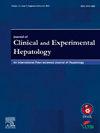Plasma Exchange With Corticosteroids as a Rescue Therapy for Severe Prolonged Cholestasis in Acute Viral Hepatitis
IF 3.2
Q2 GASTROENTEROLOGY & HEPATOLOGY
Journal of Clinical and Experimental Hepatology
Pub Date : 2025-05-20
DOI:10.1016/j.jceh.2025.102594
引用次数: 0
Abstract
Background and aims
Prolonged cholestasis after acute viral hepatitis (AVH) complicates <1% of patients. The treatment includes the use of anti-pruritic medications in a stepwise manner. This study assessed the role of Plasma exchange (PLEX) with corticosteroids on severe prolonged cholestasis.
Methods
Retrospective analysis of patients with AVH and prolonged cholestasis was conducted. Prolonged cholestasis was defined as jaundice for >6 weeks with peak serum bilirubin >10 mg/dL, in the absence of haemolysis and renal failure with alanine transferase level below 500U/L. A combination of centrifugal PLEX with corticosteroids was offered if there was no response to anti-pruritic medications. A control group, which received only anti-pruritic medications, was included for comparison.
Results
Fifty-nine patients, predominantly males (90%; n = 53) were included. Most common etiology was HAV (n = 56; 94.9%) followed by HEV (n = 3; 5.1%). Despite more severe disease, (higher Visual Analogue Scale (VAS) - 9 [9-9] vs 8 [7–8], P < 0.001 and higher bilirubin - 30.6 ± 4.1 vs 27.3 ± 7.1 mg/dL, P = 0.03), bilirubin reduction was faster in combination group. Percentage reduction in bilirubin at week 1 and week 4 was 43.6% ± 7.9% and 93.8% ± 1.6% in the combination group vs 37.9% ± 12.9% and 89.4% ± 4.4% in the conservative group (P = 0.04 and < 0.001, respectively). Median time to symptom improvement was less in the combination group (25 [22–27] days vs 42 [38–48] days; P < 0.001 in conservative group).
Conclusion
PLEX combined with low-dose oral steroids results in significant improvement in prolonged cholestasis and can be considered as an effective rescue therapy in patients who do not respond to standard anti-pruritic medications.

血浆糖皮质激素置换治疗急性病毒性肝炎重症持续性胆汁淤积的疗效
背景与目的急性病毒性肝炎(AVH)后持续的胆汁淤积并发症占患者的1%。治疗包括逐步使用抗瘙痒药物。本研究评估血浆交换(PLEX)与皮质类固醇对严重的长期胆汁淤积的作用。方法对AVH合并长期胆汁淤积患者进行回顾性分析。长期胆汁淤积被定义为黄疸持续6周,血清胆红素峰值为10mg /dL,没有溶血和肾衰竭,丙氨酸转移酶水平低于500U/L。如果对止痒药物没有反应,则提供离心PLEX与皮质类固醇的联合治疗。对照组只接受抗瘙痒药物治疗,作为比较。结果59例患者,男性居多(90%;N = 53)。最常见的病因是甲型肝炎(n = 56;94.9%),其次是HEV (n = 3;5.1%)。尽管疾病更严重,但更高的视觉模拟评分(VAS) -9 [9-9] vs 8 [7-8], P <;(30.6±4.1 vs 27.3±7.1 mg/dL, P = 0.03),联合组胆红素降低较快。联合治疗组第1周和第4周胆红素下降百分比分别为43.6%±7.9%和93.8%±1.6%,而保守治疗组分别为37.9%±12.9%和89.4%±4.4% (P = 0.04和<;分别为0.001)。联合治疗组到症状改善的中位时间更短(25[22-27]天vs 42[38-48]天);P & lt;保守组0.001)。结论plex联合小剂量口服类固醇可显著改善慢性胆汁淤积,可作为标准止痒药物无效患者的一种有效的抢救治疗方法。
本文章由计算机程序翻译,如有差异,请以英文原文为准。
求助全文
约1分钟内获得全文
求助全文
来源期刊

Journal of Clinical and Experimental Hepatology
GASTROENTEROLOGY & HEPATOLOGY-
CiteScore
4.90
自引率
16.70%
发文量
537
审稿时长
64 days
 求助内容:
求助内容: 应助结果提醒方式:
应助结果提醒方式:


